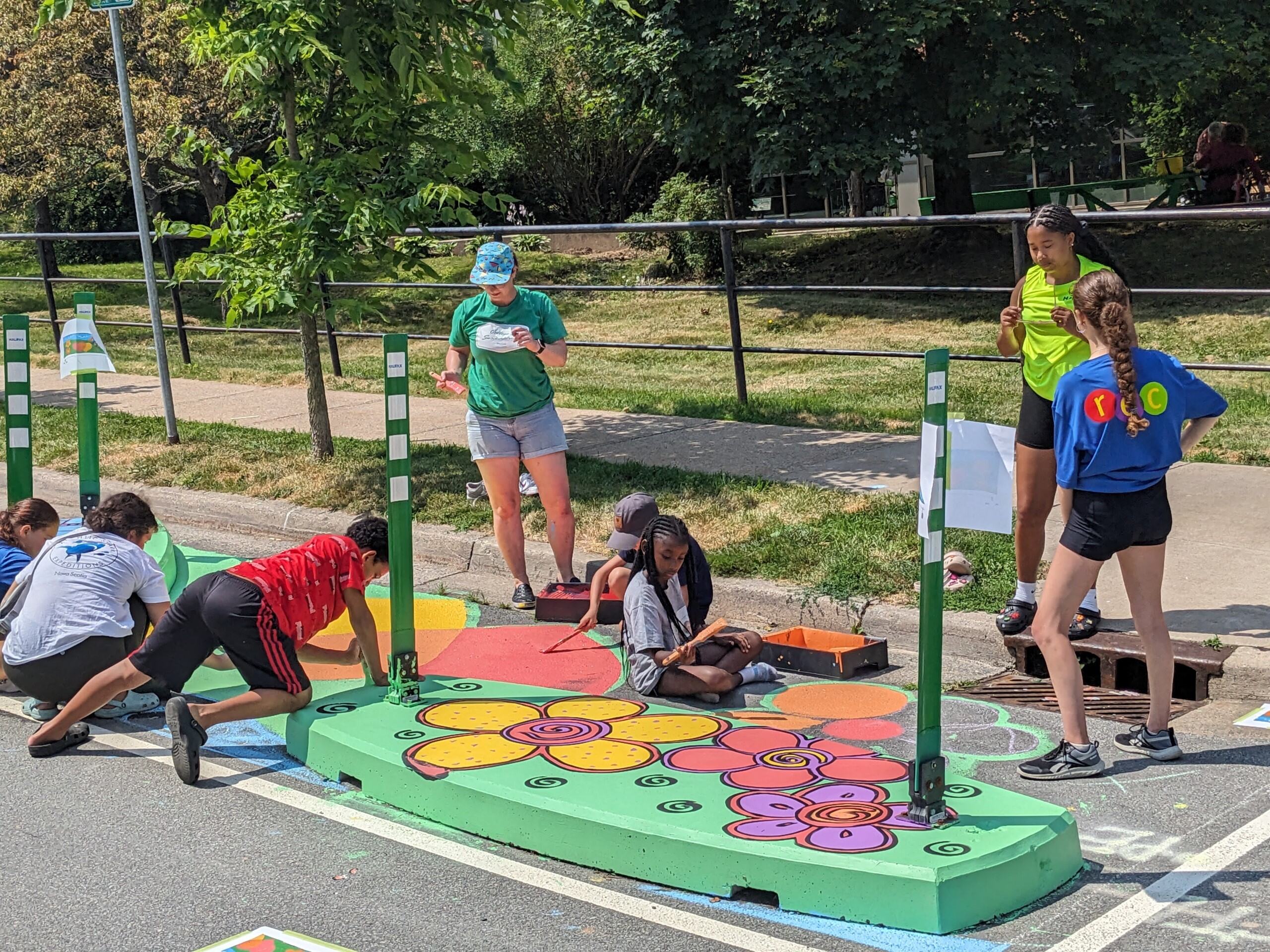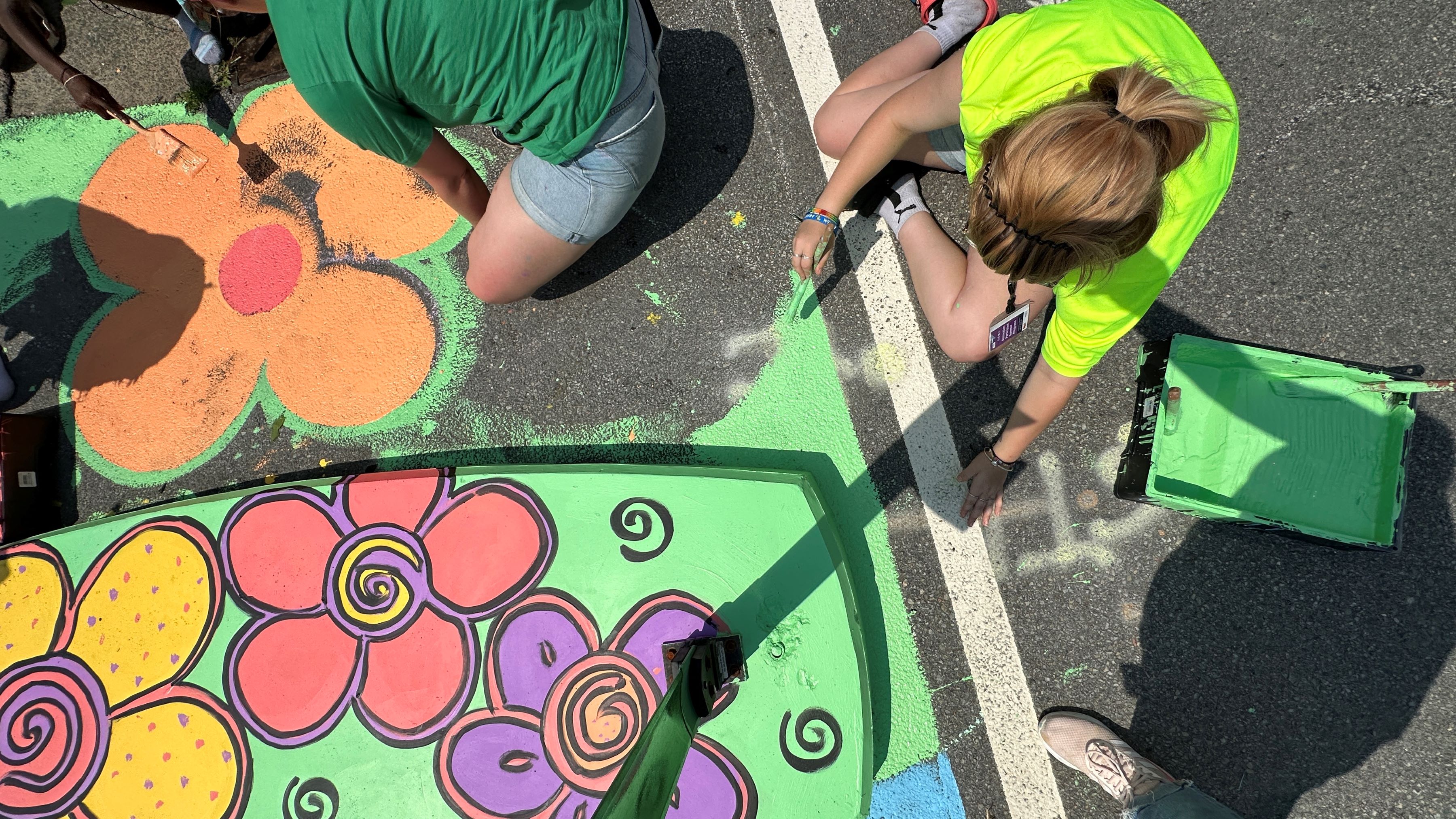
Please note that applications closed on October 17, 2025.
Funding Snapshot
Grant up to 50%* of eligible costs
The following organizations are eligible for GMF funding:
- Canadian municipal governments (e.g., towns, cities, regions, districts, and local boards)
- Local government transit agencies
- An Indigenous community is an eligible lead applicant if they are partnering with a Canadian municipal government on an eligible project, or if they have a shared service agreement with a Canadian municipal government related to municipal infrastructure, climate change or adaptation.
New or improved active transportation infrastructure along school routes in your community, including quick-build or permanent features such as pathways, sidewalks, bike lanes, crossings and safety enhancements—along with knowledge and capacity to implement these improvements effectively.
CAPACITY DEVELOPMENT
As a grant recipient, you’ll join a dynamic two-year journey designed to gain the skills, knowledge and connections to successfully plan and implement safe and active transportation projects in your community. You will receive expert training and connect with national leaders in active school travel to help drive lasting change.
As part of the cohort, you’ll receive support to:
- strengthen community engagement with proven strategies to gain school and stakeholder buy-in
- navigate challenges, policies and regulatory hurdles
- sharpen your project planning skills, including funding, infrastructure and implementation
- build collaborative relationships across sectors to support long-term success
- learn to track progress and measure impact, including GHG reductions and long-term impacts.
The pre-application deadline is October 17, 2025. Please note that the application intake will begin mid-summer.
See list of eligible costs.
This funding is intended primarily to support the design and installation of active transportation infrastructure for safe routes to school. The majority of funding should be allocated to these costs.
* The following applicants may qualify for a grant of up to 80 percent of eligible project costs:
- Municipalities (or their partners) with a population of 10,000 or under;
- regional governments or groups of municipalities where the average population of the member municipalities is 10,000 or under;
- eligible Indigenous communities; and,
- northern communities
Northern and eligible Indigenous communities that are applying to GMF for the first time may qualify for a grant of up to 100 percent of eligible costs.
The North is defined as the three territories and the northern extent of seven provinces. This includes portions of the following provinces defined by Statistics Canada codes: Newfoundland and Labrador (10), Québec (24), Ontario (35), Manitoba (46), Saskatchewan (47), Alberta (48) and British Columbia (59).
What we fund
We fund projects that aim to increase walking, biking and rolling to school through new or improved active transportation infrastructure and road safety improvements. Recipients will be supported during the planning, design and implementation stages through the peer-learning support program. Costs associated with all these projects stages are eligible for funding.
Projects must consist of a capital investment (i.e., constructing, altering or improving physical assets) and may additionally include policy measures (e.g., speed limit changes) and educational strategies. Policy measures and educational strategies alone are not eligible for funding. Eligible projects may include:
- Quick-build installations for active transportation, such as bollards, planters, paint, concrete surfboards and other removable treatments arranged to pilot new pathways, crosswalks, curb bump-outs, sidewalks, bicycle lanes, speed deterrents, etc.
- New or improved infrastructure for active transportation, such as separated bicycle lanes, more pedestrian-friendly intersections, pathways, crosswalks and connections to active transportation networks and transit networks.
- Improved active transportation infrastructure, including design considerations in which there may be no net gain in kilometres of infrastructure, but include improvements in the quality of infrastructure that encourage greater usage.
- New or improved design and safety features and facilities that promote active transportation, such as storage facilities, lighting, greenery, shade, benches, crosswalks, speed bumps, fences, signage and automated speed enforcement.

Photo courtesy of Halifax Regional Municipality

Photo courtesy of Halifax Regional Municipality
Application requirements
Applications must:
- Identify one or more routes to a primary or secondary school (or schools) as the target area for the capital project and propose an infrastructure solution to address safety-related challenges that create a barrier to active school travel for children. Grant recipients will have an opportunity through the learning program to explore various infrastructure solutions and confirm or adjust their approach.
- Demonstrate that their project will enable a significant proportion of students to walk, bike or roll to/from key destinations within 2kms of the school (e.g. home, recreation centre, transit stops) by identifying the size of the school population and the percent of students impacted
- Provide proof of a partnership between the school(s) of interest (e.g., via school administration and/or school district) and the local government applicant that indicates a willingness to collaborate on the proposed project (e.g., through a letter of support).
- Demonstrate they have complete jurisdiction over the roads, paths or land expected to be directly impacted by the project, or permission from an entity or person with jurisdiction or ownership to undertake the project.
- Demonstrate that the proposed project is a municipal commitment or part of a municipal plan or strategy. For example, the project is identified in a municipal, transportation, school or active transportation plan, school travel plan and/or be identified in an approved or proposed council resolution (that will be considered by Council prior to the project start date).
Demonstrate that projects have the potential to lead to GHG reductions through a reduction in vehicle kilometres travelled (VKT) by shifting trips to active transportation modes (walking and cycling) or other solutions that decrease vehicle use and GHGs. To help applicants set their VKT reduction targets, GMF will provide support during the application process, including guidance on estimating impacts. We recognize that available data may vary, so applicants can use a combination of the following sources. If data is incomplete, GMF can also provide default values to assist with estimates:
- Usage data (e.g., school travel surveys, census data, traffic counts)
- Mode shift estimates (e.g., peer benchmarks, survey results)
Trip characteristics (e.g., average trip to school length)
All approved recipients will have a chance to refine their baseline data and set more accurate targets through a peer-learning program, where they will also receive guidance on monitoring and reporting project outcomes.
What your project needs to achieve
Only projects that meet the criteria on this page are eligible. Please note that we consider several factors in making a funding decision. We strive to fund the most innovative and impactful initiatives as well as support communities of all sizes, so not all eligible projects will be approved for funding. Applicants must commit to actively participating in the peer learning support program to be considered for funding.
Preference will be given to initiatives that:
- will improve safety of active transportation users, with a focus on child and youth safety
- are linked to a pre-established school travel plan
- will connect to, or extend, existing active transportation networks or pathways
- consider accessibility in the project design and implementation
- are led by a multidisciplinary team, representing key roles (e.g., transportation, planning, recreation, climate, public health, parks, transit)
- are conducted in collaboration with key implementation partners (e.g. parent-teacher associations, non-profit organizations and public health organizations active in safe routes to school)
- are led by or created in collaboration with equity-deserving groups or with an Indigenous community
- contribute to the testing or demonstration of treatments, approaches and practices that are innovative
- youth and/or children contribute to, or lead, aspects of the project development and implementation (e.g. engagement, design, installation, monitoring and evaluation)
- demonstrate a strong integration of multi-solving approaches such as:
- maximizing environmental and socio-economic benefits (e.g., improved accessibility; use of recycled, natural or low-carbon materials; promoting green buffers or pollinator-friendly landscaping, promoting child-friendly neighbourhoods)
- advancing Reconciliation, equity, diversity and inclusion by addressing transportation challenges for low-income or equity-deserving groups or low-income communities
Equity considerations
GMF recognizes that many urgent social issues are interrelated, and that climate action and sustainability initiatives need to be designed to ensure fair distribution of benefits and burdens, across all segments of a community and across generations. Projects will be assessed on their potential to result in improved socio-economic outcomes and a more equitable distribution of benefits and burdens among the community, for present and future generations. While projects can be eligible without incorporating these considerations, preference is given to projects that:
- integrate principles of Reconciliation, anti-racism, equity and inclusion
- apply inclusive community engagement practices
- implement social procurement practices, for example buying from local vendors, small businesses, diverse businesses or social enterprises.
- generate other socio-economic benefits, such as improved accessibility, improved outdoor spaces and opportunities for inclusive employment and apprenticeship.
As you develop your project, consider the following questions:
- How can you design an engagement approach that would enable you to consider the diverse needs, experiences, and voices of all stakeholders and rights holders in this project?
- Which equity-deserving groups might benefit the most, and/or be burdened, directly or indirectly, by this project? How are these groups positively or negatively impacted?
- Are there opportunities to address or mitigate negative impacts?
- Are there opportunities to rectify existing or potential biases, discrimination, or exclusionary practices in your project planning, design, funding, and implementation?
- How can you maximize the socio-economic benefits that your project generates?
- How can you leverage your procurement practices to generate more positive social, economic and environmental outcomes within your community and region?
Please note that applications closed on October 17, 2025.
Need help to see if this is the right funding for you?
Contact our Outreach team who can answer any questions you have relating to this funding opportunity.

